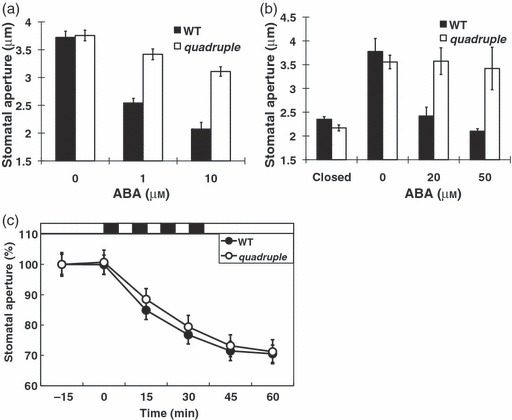Figure 5.

ABA-induced stomatal closure and ABA-inhibition of stomatal opening but not Ca2+ -induced stomatal closure are impaired in pyr1pyl1pyl2pyl4 quadruple mutant plants.
(a) ABA-induced stomatal closure in pyr1pyl1pyl2pyl4 quadruple mutant and wild type rosette leaves treated with the indicated ABA concentrations for 1 h (n = 4 experiments, 30 stomata per experiment and condition; genotype and [ABA] blind experiments).
(b) ABA inhibition of stomatal opening in pyr1pyl1pyl2pyl4 quadruple mutant and wild type abaxial leaf epidermes treated with the indicated ABA concentrations for 1 h (n = 3 experiments, 30 stomata per experiment and condition; genotype and [ABA] blind experiments). Closed means incubation in the dark for 3 h (before light and ABA treatment).
(c) Stomatal closure in response to four repetitive extracellular Ca2+ pulses (5 min each) is not impaired in pyr1pyl1pyl2pyl4 quadruple mutant suggesting that PYR/PYL/RCARs function upstream of Ca2+. Four 5-min extracellular applications of 1 mm CaCl2 and 1 mm KCl were sequentially applied to abaxial leaf epidermes (black bars at top) followed by 50 mm KCl and 0 added CaCl2 exposure (White bars at top) (n = 31 individually mapped stomata for both wild type and pyr1pyl1pyl2pyl4 quadruple mutant) Average stomatal apertures at time = −15 min: 5.24 ± 0.19 μm (wild type), 5.52 ± 0.14 μm (pyr1pyl1pyl2pyl4 quadruple mutant). Error bars show SEM.
